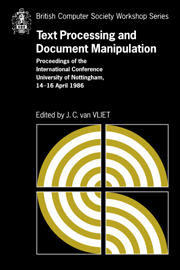 Text Processing and Document Manipulation
Text Processing and Document Manipulation Book contents
- Frontmatter
- Contents
- Preface
- The Design of Lucida®: an Integrated Family of Types for Electronic Literacy
- Tabular Typography
- A Simple Mechanism for Authorship of Dynamic Documents
- VORTEXT: VictORias TEXT reading and authoring system
- An Approach to the Design of a Page Description Language
- Intelligent Matching and Retrieval for Electronic Document Manipulation
- A Disciplined Text Environment
- Semantic Guided Editing: A Case Study On Genetic Manipulations
- Trends and Standards in Document Representation
- Textmaster – document filing and retrieval using ODA
- Combining Interactive Document Editing with Batch Document Formatting
- Formatting Structure Documents: Batch versus Interactive?
- Advanced Catalogue Production at Unipart
- Legibility of Digital Type-fonts and Comprehension in Reading
- An Overview of the W Document Preparation System
- Grif: An Interactive System for Structured Document Manipulation
- Procedural Page Description Languages
- A Strategy for Compressed Storage and Retrieval of Documents
- CONCEPT BROWSER: a System for Interactive Creation of Dynamic Documentation
- An Integrated, but not Exact-Representation, Editor/Formatter
- An Annotated Bibliography on Document Processing
- Systems used
A Simple Mechanism for Authorship of Dynamic Documents
Published online by Cambridge University Press: 05 May 2010
- Frontmatter
- Contents
- Preface
- The Design of Lucida®: an Integrated Family of Types for Electronic Literacy
- Tabular Typography
- A Simple Mechanism for Authorship of Dynamic Documents
- VORTEXT: VictORias TEXT reading and authoring system
- An Approach to the Design of a Page Description Language
- Intelligent Matching and Retrieval for Electronic Document Manipulation
- A Disciplined Text Environment
- Semantic Guided Editing: A Case Study On Genetic Manipulations
- Trends and Standards in Document Representation
- Textmaster – document filing and retrieval using ODA
- Combining Interactive Document Editing with Batch Document Formatting
- Formatting Structure Documents: Batch versus Interactive?
- Advanced Catalogue Production at Unipart
- Legibility of Digital Type-fonts and Comprehension in Reading
- An Overview of the W Document Preparation System
- Grif: An Interactive System for Structured Document Manipulation
- Procedural Page Description Languages
- A Strategy for Compressed Storage and Retrieval of Documents
- CONCEPT BROWSER: a System for Interactive Creation of Dynamic Documentation
- An Integrated, but not Exact-Representation, Editor/Formatter
- An Annotated Bibliography on Document Processing
- Systems used
Summary
ABSTRACT
It is difficult to make dynamic documents easy to use, but even more difficult to make authorship of dynamic documents simple. This paper outlines a system called GUIDE, which provides users with a modest yet powerful set of facilities for viewing documents on screens. GUIDE aims at a close integration of the author's view with the reader's view. Hie paper discusses the advantages of this approach, and the problems of adding functionality to a conceptually simple system.
Introduction
Writing good documentation is hard. Hardest of all, perhaps, is to write good user manuals for computer software. The reason why this is so difficult is that there is a great diversity of possible readers, and of modes of perusal. Readers will range from the naive to the expert, and in between there are important special cases of readers with expertise in a related area, such as a FORTRAN expert learning BASIC. Furthermore readers, whatever their background, will want to peruse the user manual in different ways at different stages in their learning process. Early on they will want summaries and tutorial information; later they may want to browse; finally they will want a reference manual. In order to cover this spectrum properly you need a huge range of user manuals. In a few spheres this range exists: there is, for example, a big range of manuals – mostly books – on Pascal and many of these are aimed at specific niches in the market of possible readers.
- Type
- Chapter
- Information
- Text Processing and Document ManipulationProceedings of the International Conference, University of Nottingham, 14-16 April 1986, pp. 34 - 42Publisher: Cambridge University PressPrint publication year: 1986
- 1
- Cited by


